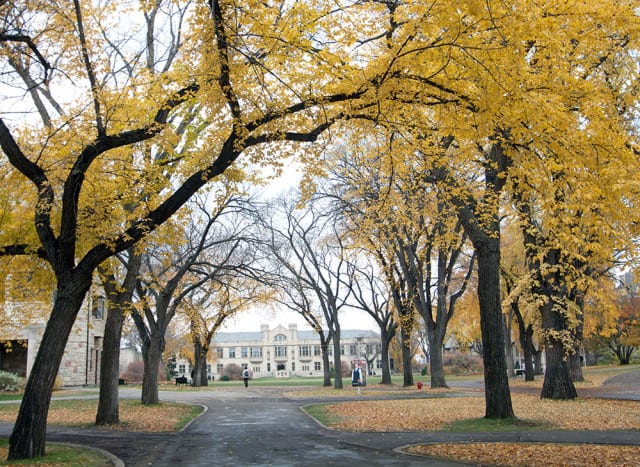
University President Ilene Busch-Vishniac talked openly with memebers of University Student Council about the vision document detailing the future of the campus.
Members of the University Student Council had the opportunity to give university president Ilene Busch-Vishniac feedback on the latest vision document at the Oct. 17 meeting.
The document, titled Vision 2025: From Spirit to Action, is the University of Saskatchewan’s concept of how it will function over the next 12 years.
Currently in the draft stage, Busch-Vishniac is consulting with the campus community for feedback on the strategy. The final version is expected to be released in the spring of 2014.
One of the key guiding principles the document states is to not “gratuitously duplicate” research or educational programs that may be found elsewhere within the province.
U of S Students’ Union President Max FineDay said he was concerned whether this meant that the vision anticipates closing any of the colleges that are present both on the U of S and University of Regina campuses, which include engineering, nursing and education.
Busch-Vishniac said the U of S is not looking to eliminate any programs that are duplicated and that this principle applies only to the creation of new programs.
“We need to create new programs where either no one is doing it yet in the province,” Busch-Vishniac said, “Or where student demand is so great … that we need a second program.
“It is not in this vision that we would necessarily be closing anything.”
Jordan Sherbino, USSU vice-president academic affairs, said he was concerned that the vision document was contradictory to the university’s purpose of serving the people of Saskatchewan by providing them with a post-secondary education. Sherbino pointed out that the vision document plans to grow and improve the university by increasing admission standards to attract the best students and that this would make it harder for Saskatchewan residents to access post-secondary education.
Busch-Vishniac said research has shown that institutions with higher admission standards receive more applicants and that this has been the case in the United States and Europe.
“The harder you make it for students to get in, the higher you raise the standards, the more attractive you become to the best students and the higher the number of applicants you get,” Busch-Vishniac said, adding that the university will have to assure that the changes to admission will not have a negative impact on underprivileged communities in Saskatchewan that seek post-secondary education.
The arrival of students in Saskatoon is positive not only for the university but for the city as well, Busch-Vishniac said. Citing Calgary Mayor Naheed Nenshi, Busch-Vishniac said that when students go to a university they often stay in that city after graduation and become taxpayers.
The absence of any recognition of the university’s satellite campuses in the document was a concern voiced by Jenna Moellenbeck, USSU vice-president operations and finance.
Moellenbeck said the USSU executives recently visited some satellite campuses and found that there was a sentiment of marginalization felt by the students therein.
Every year Busch-Vishniac does a provincial tour visiting some of the satellite campuses. She said the tours are essential in maintaining a strong partnership with these campuses.
Similarly, USSU Vice-President Student Affairs Nour Abouhamra said there was no mention of students at all in the vision and wanted to know how the university plans to address the student mental health crisis.
Busch-Vishniac assured Abouhamra that students will be re-integrated into the vision document and that, in terms of mental health, universities should be be doing more for students.
“We are seeing more and more students who have, in particular, real challenges with a variety of mental challenges,” Busch-Vishniac said. “We are not great, [here] at universities, at recognizing and dealing with those” kinds of problems.
“One of the things that we know is that when students face challenges, that affects their academic performance dramatically,” Busch-Vishniac said.
Students from the Indian Teacher Education Program and the Saskatchewan Urban Native Teacher Education Program expressed concern that a paragraph of the vision document indicated that these programs and the Northern Teacher Education Program would be cut.
Busch-Vishniac said the paragraph was poorly phrased and will be rewritten for clarity and that there is no intention of cutting these programs.
In terms of programs and the future of the U of S, the document reads that the university “will resist the temptation to see funding as more than it is — a constraint rather than a driver of what we, as a public institution, should be doing.”
When asked for clarification, Busch-Vishniac said the U of S will accept funding for projects, research and programs that are already within its broad scope of strengths and that new initiatives will not pursued simply because the funding is available.
“We have to have the authority and chutzpah to choose for ourselves what we think are the right directions and to see money as the facilitator to get us there. We will not just chase the dime,” Busch-Vishniac said.
—
Photo: Jordan Dumba/Photo Editor